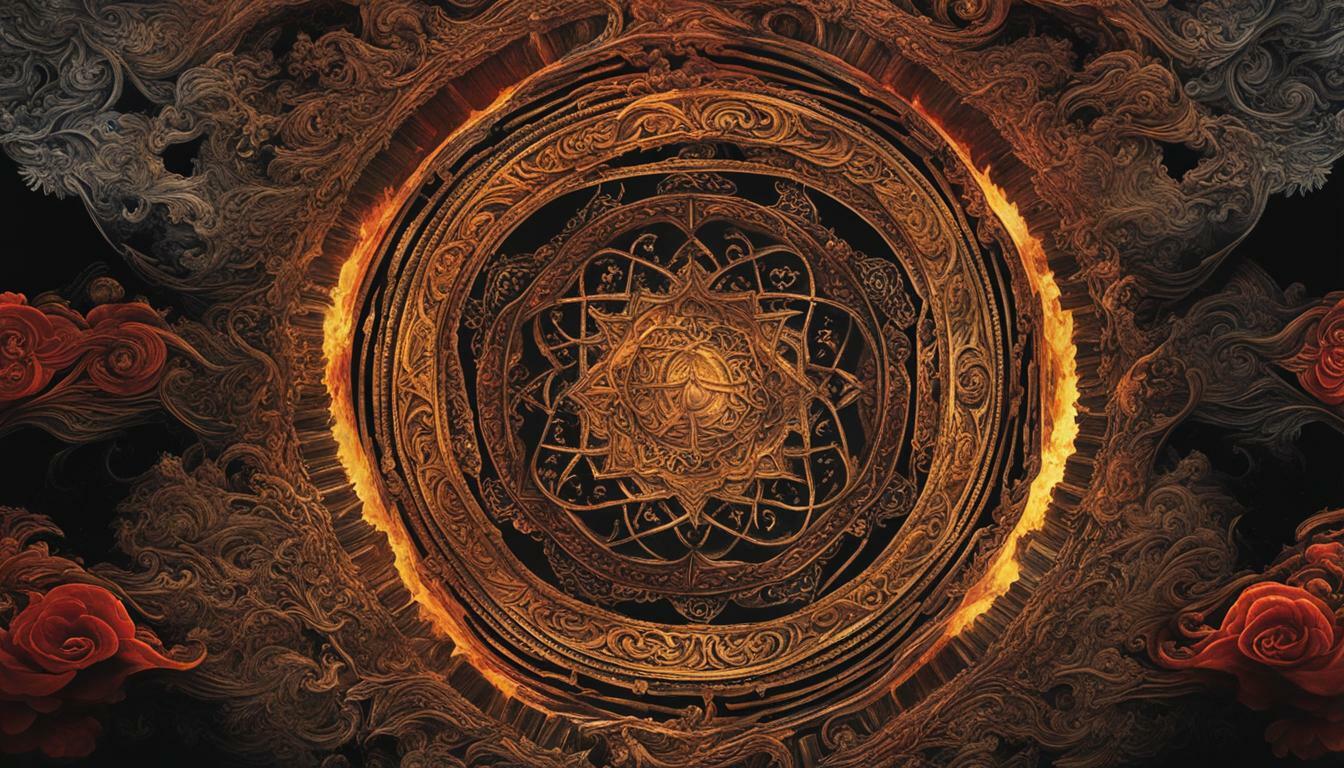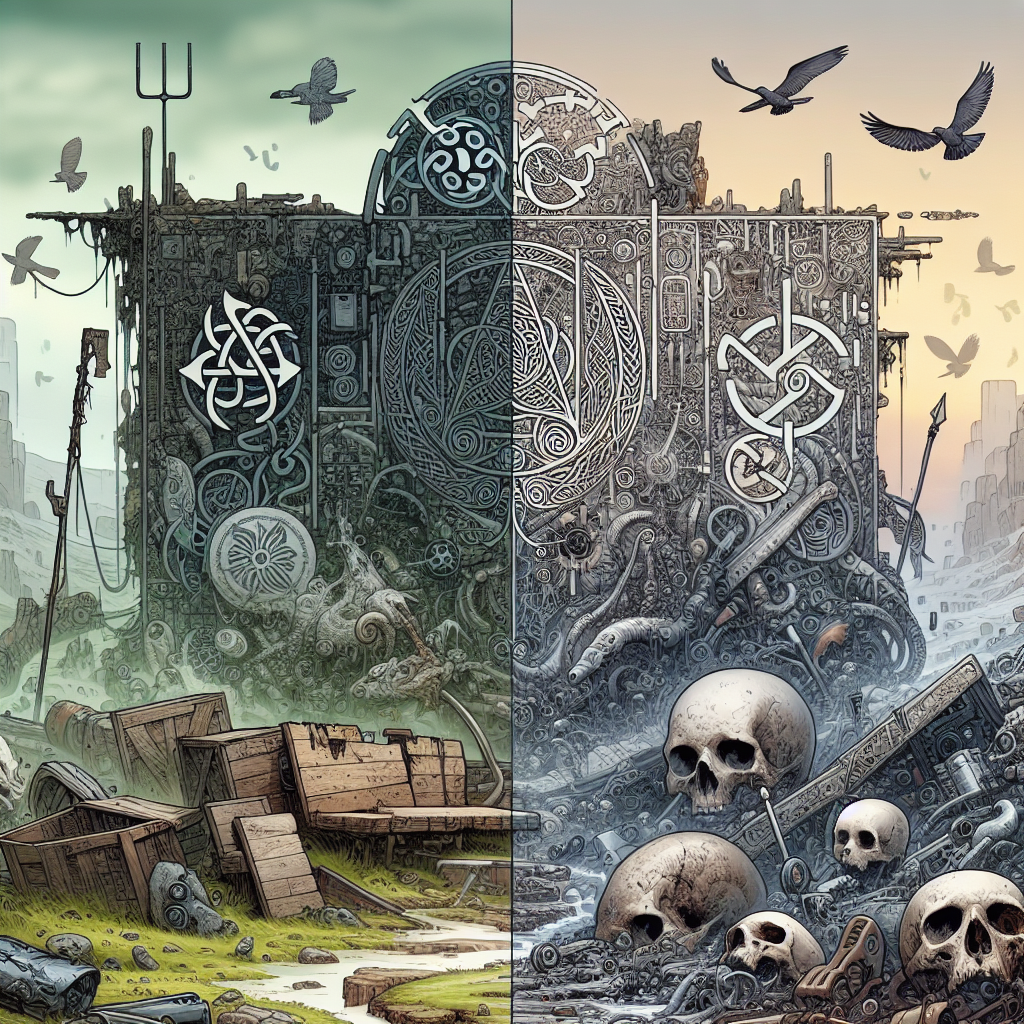Tibetan Buddhism and Catholicism have different beliefs and practices when it comes to the transitional states after death, known as Bardo in Tibetan Buddhism and Purgatory in Catholicism. The Bardo in Tibetan Buddhism is an intermediate state between death and rebirth, where the soul goes through various stages before being reincarnated. It involves symbolic visions based on one’s actions in life. The Bardo Thödol, also known as the Tibetan Book of the Dead, is a guide for the deceased in navigating the Bardo and achieving a better rebirth. On the other hand, Purgatory in Catholicism is a final purification of the soul before entering heaven. It is a state where souls are prepared to enter God’s presence and achieve the holiness necessary for heavenly joy. While both concepts involve a transitional period after death, the Bardo focuses on cleansing karma and experiencing symbolic visions, while Purgatory emphasizes purification and preparation for heaven.
Key Takeaways:
- Bardo in Tibetan Buddhism is an intermediate state between death and rebirth.
- Symbolic visions and the cleansing of karma are significant aspects of the Bardo.
- The Tibetan Book of the Dead guides individuals through the Bardo.
- Purgatory in Catholicism is a final purification before entering heaven.
- Purgatory prepares souls to achieve the holiness necessary for heavenly joy.
Bardo in Tibetan Buddhism
Bardo is a crucial aspect of Tibetan Buddhism, representing the intermediate state between death and rebirth, where the soul undergoes transformation and purification. It is believed that during this period, the consciousness of the deceased travels through different stages, encountering various symbolic visions based on their actions in life. These visions serve as opportunities for self-reflection and karmic cleansing, shaping the individual’s future rebirth.
One of the most important texts in Tibetan Buddhism is the Bardo Thödol, also known as the Tibetan Book of the Dead. This guide provides instructions and prayers for the deceased during the Bardo, offering guidance on how to navigate the transitional state and attain a favorable rebirth. It emphasizes the importance of awareness and mindfulness, urging individuals to recognize the illusory nature of the visions they encounter and to cultivate positive qualities such as compassion and wisdom.
The practices associated with Bardo in Tibetan Buddhism include meditation, chanting of mantras, and recitation of prayers. These practices aim to create a conducive environment for the deceased, enabling them to navigate the Bardo with clarity and transcend negative karmic patterns. By engaging in these practices, individuals seek to accumulate positive merits and purify their consciousness, ultimately paving the way for a favorable rebirth in their next life.
| Bardo in Tibetan Buddhism | Purgatory in Catholicism |
|---|---|
| Intermediate state between death and rebirth | Final purification of the soul before entering heaven |
| Involves symbolic visions and karmic cleansing | Emphasizes purification and preparation for heaven |
| Guided by the Bardo Thödol (Tibetan Book of the Dead) | A state where souls are prepared to enter God’s presence |
Quotes:
Bardo is a profound and transformative phase in Tibetan Buddhism, offering individuals the opportunity to confront their past actions and shape their future existence through self-reflection and purification.
The practices associated with Bardo, including meditation and recitation of prayers, are aimed at helping individuals navigate the intermediate state with clarity and accumulate positive merits for a favorable rebirth.
- Symbolic visions in the Bardo serve as mirrors reflecting one’s actions in life and provide opportunities for karmic cleansing.
- The Bardo Thödol is a valuable guide that offers instructions and prayers for the deceased during their journey through the intermediate state.
- Through engagement in Bardo practices, individuals seek to purify their consciousness and transcend negative karmic patterns, ultimately paving the way for a better rebirth.
In summary, Bardo in Tibetan Buddhism is a transformative phase representing the intermediate state between death and rebirth. It emphasizes symbolic visions, karmic cleansing, and the guidance provided in the Bardo Thödol. The practices associated with Bardo aim to create a conducive environment for the deceased to navigate this transitional period and attain a favorable rebirth. In contrast, Purgatory in Catholicism is a final purification of the soul before entering heaven, focusing on preparation for divine presence and achieving holiness. While both concepts share a transitional period after death, they differ in their emphasis and practices.
Purgatory in Catholicism
Purgatory holds a significant place in Catholicism, serving as a state of final purification where souls prepare themselves for the joy of heaven in the presence of God. It is believed that after death, the soul may still require cleansing from the temporal punishment due to sin before it can enter into the fullness of heavenly bliss. Purgatory offers a space for this purification, allowing individuals to undergo a transformative process that purges any remaining impurities.
During their time in Purgatory, souls experience a period of suffering that is distinct from the eternal damnation of hell. This suffering, however, is not punitive but rather remedial, aiming to purify the soul and remove any remaining attachment to sin. It is seen as an act of God’s mercy, providing an opportunity for souls to attain the holiness necessary for union with God.
The concept of Purgatory in Catholicism emphasizes the importance of prayers, masses, and indulgences for the souls in Purgatory. It is believed that through these acts of spiritual devotion, the living can assist the souls undergoing purification, helping to shorten their time in Purgatory and bring them closer to their ultimate goal of heavenly joy.
| Similarities between Bardo and Purgatory | Differences between Bardo and Purgatory |
|---|---|
|
|
Similarities and Differences between Bardo and Purgatory
Although Bardo and Purgatory both represent transitional states, they differ in their focus on cleansing karma and experiencing symbolic visions versus purification and preparation for heaven. In Tibetan Buddhism, the Bardo is an intermediate state between death and rebirth, where the soul goes through various stages before being reincarnated. This concept is based on the belief that one’s actions in life determine their experiences in the Bardo. The Bardo Thödol, also known as the Tibetan Book of the Dead, provides guidance for the deceased, helping them navigate the Bardo and achieve a better rebirth.
On the other hand, Purgatory in Catholicism is seen as a final purification of the soul before entering heaven. It is a state where souls are prepared to enter God’s presence and achieve the holiness necessary for heavenly joy. The focus in Purgatory is on purifying the soul from any remaining imperfections and sins, thereby preparing it for eternal bliss in the presence of God.
While both Bardo and Purgatory involve a transitional period after death, they have distinct purposes and practices. Bardo emphasizes the cleansing of karma and the experience of symbolic visions that reflect one’s actions in life. It is an opportunity for self-reflection, growth, and the resolution of past actions. In contrast, Purgatory is focused on purification and preparation for heaven, with the intention of removing any remaining imperfections and attaining holiness.
In summary, Bardo in Tibetan Buddhism and Purgatory in Catholicism share the commonality of representing transitional states after death. However, they differ in their specific objectives and practices. Bardo centers around cleansing karma and experiencing symbolic visions, while Purgatory focuses on purifying the soul and preparing it for the ultimate union with God in heaven.
Understanding Bardo Practices in Tibetan Buddhism
Tibetan Buddhism offers various practices to prepare individuals for the Bardo, including meditation and following the guidance found in the Tibetan Book of the Dead. These practices are designed to help navigate the intermediate state between death and rebirth, and to ensure a favorable outcome in the next life.
Meditation plays a central role in Tibetan Buddhism practices related to the Bardo. By cultivating a focused and calm mind, individuals can better navigate the uncertainties and symbolic visions that arise during the Bardo. Through meditation, practitioners can develop awareness of their own actions, ultimately influencing their future rebirths.
The Tibetan Book of the Dead, also known as the Bardo Thödol, is a key guide for individuals transitioning through the Bardo. It provides instructions and rituals to help the deceased understand the experiences and visions they encounter, and to make conscious choices that will lead to a positive rebirth. The book offers prayers, mantras, and visualizations that aid in navigating the Bardo stages and achieving a better outcome.
| Practices in Tibetan Buddhism for the Bardo | Description |
|---|---|
| Meditation | Helps cultivate a focused mind and awareness of one’s actions, influencing future rebirths. |
| Tibetan Book of the Dead | Offers guidance, instructions, and rituals to navigate the Bardo stages and achieve a positive rebirth. |
Quote:
“Meditation is the key to unlocking the wisdom of the Bardo. Through a calm and focused mind, practitioners can navigate the symbolic visions and make conscious choices that shape their future rebirths.” – Tibetan Buddhism practitioner
In conclusion, Tibetan Buddhism practices provide individuals with tools to prepare for the Bardo, ensuring a better transition to their next life. By engaging in meditation and following the guidance found in the Tibetan Book of the Dead, practitioners can cultivate awareness, navigate the uncertainties of the intermediate state, and ultimately influence their future rebirths in a positive way.
Conclusion
In conclusion, the concepts of Bardo in Tibetan Buddhism and Purgatory in Catholicism offer distinct perspectives on the transitional states after death, with varying beliefs, practices, and purposes.
The Bardo in Tibetan Buddhism is an intermediate state between death and rebirth, where the soul goes through various stages before being reincarnated. It involves symbolic visions based on one’s actions in life. The Bardo Thödol, also known as the Tibetan Book of the Dead, is a guide for the deceased in navigating the Bardo and achieving a better rebirth.
On the other hand, Purgatory in Catholicism is a final purification of the soul before entering heaven. It is a state where souls are prepared to enter God’s presence and achieve the holiness necessary for heavenly joy.
While both concepts involve a transitional period after death, the Bardo focuses on cleansing karma and experiencing symbolic visions, while Purgatory emphasizes purification and preparation for heaven.
FAQ
What is the Bardo in Tibetan Buddhism?
The Bardo in Tibetan Buddhism is an intermediate state between death and rebirth, where the soul goes through various stages before being reincarnated. It involves symbolic visions based on one’s actions in life.
What is the Bardo Thödol?
The Bardo Thödol, also known as the Tibetan Book of the Dead, is a guide for the deceased in navigating the Bardo and achieving a better rebirth.
What is Purgatory in Catholicism?
Purgatory in Catholicism is a final purification of the soul before entering heaven. It is a state where souls are prepared to enter God’s presence and achieve the holiness necessary for heavenly joy.
How are the Bardo and Purgatory different?
While both concepts involve a transitional period after death, the Bardo focuses on cleansing karma and experiencing symbolic visions, while Purgatory emphasizes purification and preparation for heaven.
 Skip to main content
Skip to main content


